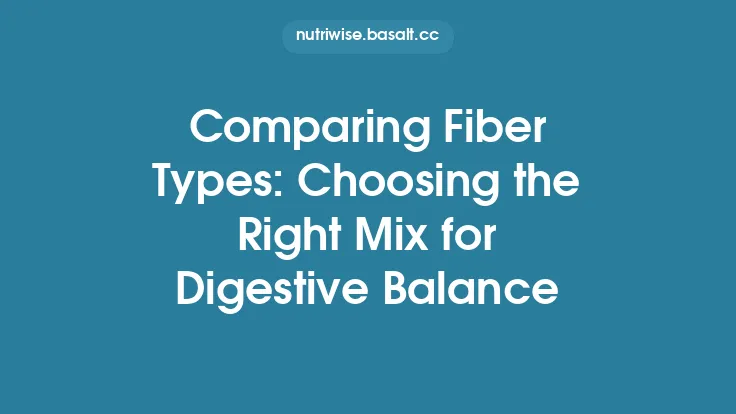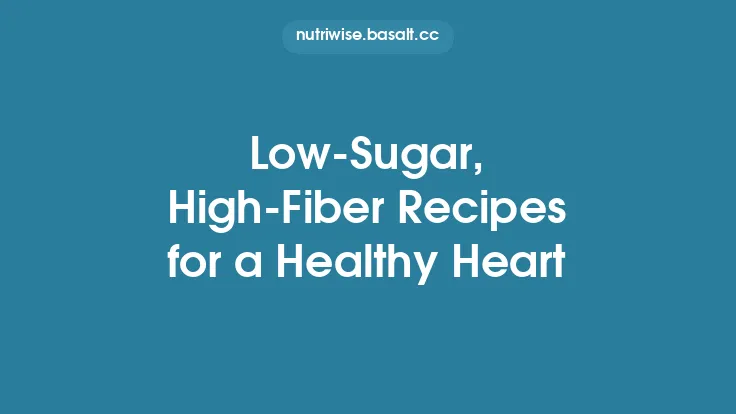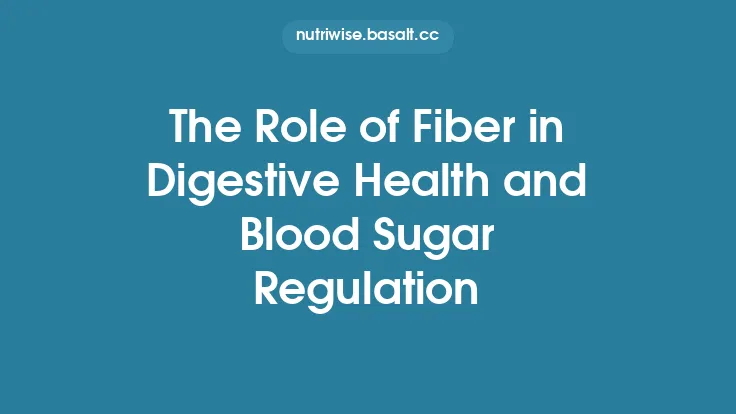Resistant starch (RS) has emerged as a unique class of dietary carbohydrate that reaches the large intestine largely intact, where it becomes a substrate for microbial fermentation. Unlike the more familiar soluble and insoluble fibers, RS is a form of starch that resists enzymatic digestion in the small intestine, offering a distinct set of physiological actions that support colon health. This article delves into the chemistry, sources, digestive pathway, and colon‑centric benefits of resistant starch, providing a comprehensive resource for anyone interested in the science of this fermentable fiber.
What Is Resistant Starch?
Resistant starch is defined by its ability to escape hydrolysis by pancreatic α‑amylase and brush‑border enzymes in the upper gastrointestinal tract. While most dietary starches are rapidly broken down into glucose, RS remains in a granular or retrograded form that is not readily accessible to human digestive enzymes. Consequently, a substantial portion of ingested RS arrives in the colon where it is metabolized by the resident microbiota.
Key characteristics that set RS apart from other carbohydrates include:
- Low glycemic impact – because it is not absorbed as glucose in the small intestine, RS contributes minimally to post‑prandial blood sugar spikes.
- Fermentability – the colonic microbiota possess a repertoire of amylolytic enzymes capable of degrading RS, producing metabolites that influence the colonic environment.
- Physicochemical stability – RS can persist through cooking, cooling, and even certain processing steps, depending on its structural subtype.
Classification of Resistant Starch (RS1–RS5)
Researchers have categorized RS into five principal subtypes based on structural origin and the mechanisms that confer resistance:
| Subtype | Source / Structural Basis | Mechanism of Resistance |
|---|---|---|
| RS1 | Physically inaccessible starch trapped within intact cell walls (e.g., whole grains, seeds, legumes). | Physical barrier prevents enzyme access. |
| RS2 | Native granular starch with a high proportion of amylose (e.g., raw potatoes, unripe bananas, high‑amylose corn). | Crystalline granules are inherently resistant to α‑amylase. |
| RS3 | Retrograded starch formed when gelatinized starch is cooled (e.g., cooked‑and‑cooled rice, pasta, potatoes). | Re‑association of amylose and amylopectin chains creates ordered, less digestible structures. |
| RS4 | Chemically modified starches (e.g., cross‑linked, phosphorylated, or esterified starches). | Covalent modifications hinder enzymatic cleavage. |
| RS5 | Starch–lipid complexes (e.g., amylose–fat complexes formed during certain cooking processes). | Inclusion complexes with lipids protect starch from enzymatic attack. |
Understanding these subtypes is essential for both food scientists designing RS‑enriched products and consumers seeking to maximize RS intake through dietary choices.
Major Dietary Sources and How Preparation Affects Content
| Food Item | Typical RS Content (g per 100 g) | Preparation Tips |
|---|---|---|
| Unripe (green) bananas | 4–5 | Consume raw; ripening reduces RS as starch converts to sugars. |
| High‑amylose corn | 6–8 (raw) | Use as flour; cooking may lower RS unless cooled. |
| Cooked‑and‑cooled potatoes | 2–3 | Boil, cool in the refrigerator for ≥12 h; reheating does not fully reverse retrogradation. |
| Cooked‑and‑cooled rice or pasta | 1–2 | Follow the same cooling protocol; adding a small amount of oil can promote RS5 formation. |
| Legumes (e.g., lentils, chickpeas) | 1–2 (dry) | Soak and cook, then cool; the intact cell walls preserve RS1. |
| Whole‑grain breads (especially those made with high‑amylose flour) | 1–2 | Choose breads with minimal added sugars and a dense crumb. |
| Modified starch products (e.g., resistant starch powders) | 80–90 (dry) | Can be incorporated into smoothies, yogurts, or baked goods; heat stability varies by modification. |
The interplay between cooking temperature, moisture, and cooling time determines the proportion of RS3 formed. For example, a 100 g serving of boiled rice may contain ~0.5 g RS, but after cooling for 12 h, RS can increase to ~1.5 g. This dynamic underscores the practical relevance of food handling in modulating RS intake.
Digestive Journey: From Mouth to Colon
- Oral Phase – Mechanical breakdown by chewing increases surface area, but salivary α‑amylase has limited effect on RS because the resistant structures are not readily accessible.
- Stomach – The acidic environment (pH ≈ 2) does not hydrolyze RS; gastric motility merely mixes the bolus.
- Small Intestine – Pancreatic α‑amylase and brush‑border maltase act efficiently on digestible starches, converting them to maltose and glucose. RS, however, remains largely unchanged, passing through the jejunum and ileum largely untouched.
- Colon – Upon arrival, RS becomes a substrate for a subset of colonic bacteria equipped with amylolytic enzymes (e.g., *Ruminococcus bromii, Bifidobacterium adolescentis*). Fermentation proceeds anaerobically, yielding gases (CO₂, H₂, CH₄) and short‑chain fatty acids (SCFAs). While SCFAs are a well‑studied outcome, the focus here is on how the fermentation process itself reshapes the colonic milieu.
Microbial Fermentation in the Colon
The colon hosts a dense and diverse microbial ecosystem. RS fermentation is characterized by:
- Selective enrichment – Certain bacterial taxa possess the enzymatic machinery to degrade the crystalline or retrograded starch structures. Their proliferation can shift the overall community composition toward amylolytic and butyrate‑producing groups.
- Gradual fermentation – Unlike rapidly fermentable soluble fibers, RS is broken down more slowly, providing a sustained substrate over several hours. This prolonged activity helps maintain a relatively stable colonic pH and nutrient supply for the epithelium.
- Gas production – Fermentation generates modest amounts of hydrogen and carbon dioxide, which are typically well tolerated. Excessive gas formation is less common with RS than with highly fermentable oligosaccharides.
Health Implications for Colon Integrity
1. Butyrate‑Mediated Epithelial Support
Although the detailed pathways of SCFA production are covered elsewhere, it is noteworthy that the slow, continuous fermentation of RS tends to favor the generation of butyrate—a preferred energy source for colonocytes. Adequate butyrate supply supports tight‑junction integrity, mucosal barrier function, and cellular turnover, all of which are central to a healthy colon lining.
2. Modulation of Luminal pH
The acidic by‑products of RS fermentation lower colonic pH modestly (typically to 5.5–6.0). A slightly acidic environment discourages the growth of pathogenic bacteria that thrive at neutral pH, thereby contributing to a more balanced microbial ecosystem.
3. Reduction of Carcinogen Exposure
Epidemiological and mechanistic studies suggest that RS intake can diminish the exposure of the colonic epithelium to secondary bile acids and other pro‑carcinogenic metabolites. The protective effect is thought to arise from both the physical presence of RS (binding bile acids) and the metabolic shift toward beneficial fermentation products.
4. Stool Bulk and Water Retention
RS adds to fecal mass through its fiber‑like properties and the microbial biomass generated during fermentation. This increase in bulk can aid in maintaining regular colonic transit without directly addressing constipation or diarrhea, which are covered in separate articles.
Influence on Gut Microbiota Composition
Research employing 16S rRNA sequencing and metagenomic analyses has consistently shown that RS consumption leads to:
- **Enrichment of *Ruminococcus bromii*** – Often termed a “keystone” amylolytic species, its presence is strongly correlated with efficient RS degradation.
- **Growth of *Bifidobacterium* spp.** – While traditionally classified as prebiotic responders, these bacteria also possess amylolytic capabilities that allow them to benefit from RS.
- **Increase in *Faecalibacterium prausnitzii*** – A known anti‑inflammatory commensal that thrives in environments with sustained SCFA production.
- Overall rise in microbial diversity – The gradual release of fermentable substrate supports a broader range of metabolic niches, fostering a resilient microbiome.
These compositional shifts are associated with improved mucosal immunity and reduced markers of low‑grade inflammation, underscoring the colon‑centric benefits of RS.
Resistant Starch and Metabolic Outcomes
Beyond the colon, RS exerts systemic effects that are indirectly linked to colonic health:
- Attenuated post‑prandial glucose excursions – By delaying carbohydrate absorption, RS blunts the glycemic spike that follows a meal, which can be advantageous for individuals with insulin resistance.
- Improved lipid profile – Some intervention trials have reported modest reductions in LDL‑cholesterol and triglycerides, possibly mediated through altered bile acid metabolism.
- Satiety signaling – Although the satiety article is excluded, it is worth noting that the fermentation process can influence gut‑derived hormones (e.g., GLP‑1) that regulate appetite, albeit this effect is secondary to the primary colon benefits discussed here.
Practical Strategies to Incorporate Resistant Starch into the Diet
- Embrace the “cook‑cool‑reheat” cycle – Prepare starchy foods (rice, potatoes, pasta), cool them in the refrigerator for at least 12 hours, and optionally reheat gently. This maximizes RS3 formation.
- Add unripe bananas to smoothies – Slice a half‑ripe banana and blend it with yogurt or plant‑based milk for a natural RS boost.
- Select high‑amylose grain products – Look for breads, cereals, or flours labeled “high‑amylose” or “resistant starch enriched.”
- Include legumes in salads – Use cooled, cooked beans or lentils to preserve RS1 content.
- Supplement judiciously – Commercial RS powders (often derived from high‑amylose corn) can be mixed into beverages or baked goods. Start with 5 g per day and increase gradually to avoid gastrointestinal discomfort.
- Combine with healthy fats – Adding a modest amount of oil during cooking can promote RS5 formation, especially in starchy dishes like roasted potatoes.
Current Research Gaps and Future Directions
- Long‑term colon cancer outcomes – While short‑term biomarkers suggest protective effects, large‑scale prospective studies are needed to confirm RS’s role in reducing colorectal cancer incidence.
- Individual variability in RS fermentation – Genetic and microbiome differences dictate how efficiently a person can degrade RS. Personalized nutrition approaches could tailor RS recommendations based on microbial profiling.
- Interaction with other dietary components – The synergistic or antagonistic effects of RS when combined with polyphenols, proteins, or other fibers remain underexplored.
- Novel RS‑rich ingredients – Emerging processing technologies (e.g., extrusion, high‑pressure cooking) may create new RS forms with enhanced stability and health benefits.
Guidelines and Recommended Intake
There is no universally established daily target for resistant starch, but expert consensus suggests:
- General adult population: 15–30 g of RS per day, achievable through a combination of whole foods and, if desired, fortified products.
- Individuals with metabolic concerns: Higher intakes (up to 40 g) may confer additional glycemic benefits, provided tolerance is monitored.
The recommended intake aligns with the broader dietary fiber guideline of 25–30 g per day, recognizing that RS contributes to the total fiber pool while offering distinct colon‑focused advantages.
Resistant starch stands out as a fermentable carbohydrate that uniquely bridges the gap between undigested starch and beneficial colonic fermentation. By understanding its classifications, food sources, and physiological impacts, both food scientists and health‑conscious consumers can harness RS to promote a resilient colon environment and support overall digestive well‑being.





